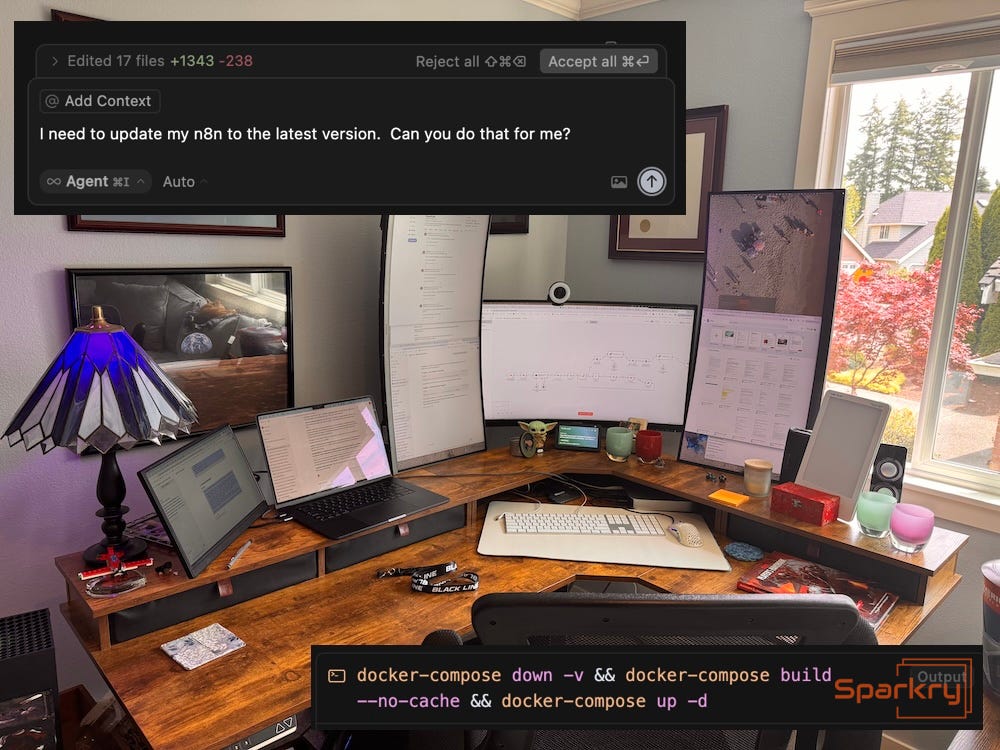Two Weeks of AI Workflows Gone in Two Sentences: A Father's Day Disaster Story
Sunday morning quiet. Coffee brewing in the kitchen. My Mac Mini humming in the corner of my home office while my family got ready for church. Thirty stolen minutes to move the Sparkry Stack forward before we had to leave.
I pulled up my n8n instance, feeling that familiar excitement of seeing clean workflows ready for production. The Sparkry Stack Beta launch was just a week away, and everything was finally coming together.
Then I typed two sentences that would erase two weeks of work.

The Setup: Building Something Real
Those weren't just test workflows sitting in my production environment. I'd built a daily newsletter system that used Tavily to research AI, solopreneur, agentic AI, and neurodivergent news — automatically curating content that would have taken me hours to find manually.
The crown jewel was a Blotato integration that could take any piece of content and explode it across every platform: LinkedIn posts with professional polish, Facebook updates for community building, BlueSky threads that felt native to the platform. It could even generate headless TikTok videos with auto-created content.
These weren't proof-of-concepts anymore. The social media reposter alone was going to save me 2.5 hours per week — real time I could spend on trail rides or building the next iteration. This was the infrastructure that would let me scale BlackLine Apparel without becoming a prisoner to my own business.

The Fatal Prompt
I fired up Cursor without checking my deployment docs first. Classic ADHD move — hyperfocus on the end goal, skip the boring safety steps.
"I need to update my n8n to the latest version. Can you do that for me?"
That was it. Thirty-seven characters that would teach me the most expensive lesson of my entrepreneurial career.
I walked away to make my London Fog, humming some random song, already mentally planning the Beta launch announcement. When I came back, Cursor was still churning through commands. Then I saw it:
docker-compose down -v && docker-compose build --no-cache && docker-compose up -d.
That -v flag hit me like ice water. I watched that command execute with the same horrified fascination you'd have watching a controlled demolition of your own house. The command finished. My terminal went quiet. Even the server seemed to pause, as if it knew what it had just done. The -v flag removes named volumes declared in the compose file — which meant my database, all my workflows, everything had just vanished.
The upgrade worked perfectly. The data wipe was surgical.
When Backups Become Lies We Tell Ourselves
My GitHub backup process had been running for months. Surely it would save me, right?
Wrong. Those backups had been silently failing for 2-3 weeks, and I'd never bothered to verify they were actually working. It's the automation paradox every solo founder faces: we automate the things we should be monitoring, then forget to monitor the automation.
Studies show that more than half of all data backups fail, and 96% of businesses don't even back up their workstations. I'd just joined the club nobody wants to be in.
Only about 25% of my workflows survived — the handful I'd downloaded locally or had copies on a different server. Two weeks of architectural thinking, custom integrations, and hard-won configuration tweaks: gone.
The Neurodivergent Founder's Paradox
Here's what the disaster really exposed: the constant war between my ADHD brain and my systematic brain.
ADHD Travis had gotten so excited about building new features that he'd neglected the boring infrastructure work. The hyperfocus that let me build complex workflows in n8n in marathon sessions was the same trait that made me skip backup verification for weeks.
But the systematic side of my brain knew better. The part that engineered systems for 30,000 transactions per second at Amazon was screaming that I needed bulletproof infrastructure. That's the voice that kept me awake at night worrying about single points of failure.
Every startup guru tells you to "move fast and break things." But when you're neurodivergent, that advice becomes dangerous. My ADHD wants to chase every shiny improvement, while the systematic side knows that broken systems mean broken promises to customers.
But here's what I learned about disasters when you're building in the margins: they force the architectural improvements you were too busy to make. Time to let the systematic side of my brain take the wheel. Full infrastructure mode: engaged.
The Three-Layer Recovery Protocol
Here's the field-tested, paranoid backup system I built from the wreckage:
Layer 1: Workflow Self-Monitoring Every critical n8n workflow now includes Telegram notifications. Success messages go to my normal update channel, failures trigger my Sev2 alert channel. The workflows police themselves.
Layer 2: Backup Verification Workflow A separate n8n workflow runs daily, checking that expected backups actually exist in GitHub. If it doesn't find them, it fires a Sev1 alert to my emergency channel. Sev1 alert = immediate Telegram message plus SMS backup: "n8n backup verification failed. Last successful backup: 3 days ago. Action required."
Layer 3: External Monitoring Third-party service monitoring my n8n production instance. If the whole system goes down, I get alerted instantly. Three independent systems watching each other.
The Sparkry Stack Beta launches June 30th, built on infrastructure that won't crumble from a careless prompt to an AI assistant.
Building in the margins means disasters happen during stolen time windows. The question isn't whether you'll lose work — it's whether you'll build systems that make the second attempt stronger than the first.
What's your two-sentence disaster waiting to happen? The Sparkry Stack Beta launches June 30th with the backup protocols I built from this disaster.





